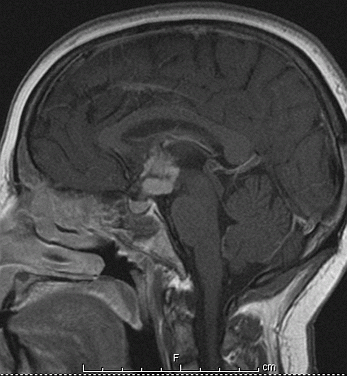SFEBES2012 Poster Presentations Pituitary (43 abstracts)
Neurosarcoidosis presenting with anterior hypopituitarism and hypothalamic syndrome
Emanuela Bejinariu & Anitha Mathews
Department of Endocrinology, Hinchingbrooke Hospital, Huntingdon, United Kingdom.
Introduction: We present a case of neurosarcoidosis presenting with anterior hypopituitarism and hypothalamic syndrome.
Case Report: A 38-years old Caucasian woman presented from primary care with six-month history of secondary amenorrhoea. Additionally she reported non-specific tiredness, postural dizziness, nausea and abdominal pains. Over the same period she noticed progressive weight gain of three stones, increased somnolence, lethargy and excessive sweating. She was morbidly obese (BMI 46.8) with central obesity and mild pyrexia was noted. Biochemical tests including Short Synacthen Test showed evidence of central hypoadrenalism, secondary hypothyroidism and hypogonadism. There was mild hyperprolactinaemia up to 900 mU/L and normal posterior pituitary axis. She was commenced on hydrocortisone and thyroxine replacement. MRI imaging revealed an extensive mass in the hypothalamus infiltrating the pituitary stalk and pituitary gland, also extending caudally upto the third ventricle walls and floor with possible impending hydrocaephalus. CT imaging of thorax/abdomen/pelvis revealed extensive bilateral mediastinal and intra-abdominal lymphadenopathy. Mediastinoscopic lymph node excision biopsy revealed numerous non-caseating granulomas with no organisms identified on staining. Calcium levels and autoimmune screen were normal. Serum ACE was raised at 112 U/l (0–52). A diagnosis of Neurosarcoidosis was made and treatment started with high dose steroids. MRI and CT imaging after four-weeks showed radiological improvement in hypothalamic infiltration and reduction in systemic lymphadenopathy. Serum ACE levels normalised.
Conclusion: This case illustrates a rare presentation of neurosarcoidosis with secondary amenorrhoea and hypothalamic syndrome. Features of hypothalamic syndrome in this case included morbid obesity, hyperphagia, flattened affect, hypersomnolence, pyrexia and glycaemic dysregulation (HbA1c 7.2% prior to commencement of steroid treatment). These improved on steroid treatment, leading to remarkable weight loss achievement. The multi-system involvement of sarcoidosis in our case enabled us to get a confirmatory histological diagnosis from mediastinal lymph node excision biopsy. Prompt initiation of treatment in this patient avoided complications such as hydrocaephalus.

Declaration of interest: There is no conflict of interest that could be perceived as prejudicing the impartiality of the research reported.
Funding: No specific grant from any funding agency in the public, commercial or not-for-profit sector.




